More Than Just Succulents in the Landscape
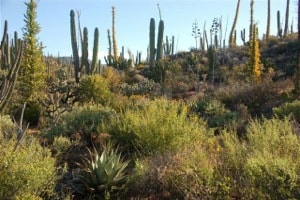
The distinctive flora of the San Diego, Baja and Sonoran Desert regions are just that – distinctive.
REGIONAL ASPECT
The vegetation of northern Baja California is among the most interesting and unique in the world. A journey through the deserts or mountains, along the coast of the Pacific or the beaches of the Sea of Cortéz, is a guaranteed eye-opener to anyone interested in natural history. Much of this fascinating flora extends well into southern California, especially rich in San Diego County, and can still be appreciated in reserves and parks where it has been protected from destruction by development. We are very fortunate to have these living models of functional ecosystems so close at hand.
See our new plant list and read this entire article…..
When we include the desert to the east, (the Sonoran Desert, of which most of Baja is technically a part), and select plant species from the entire region; San Diego, Baja and the Sonoran Desert, we can create wonderfully “natural” gardens with a local “desert” theme. The scientific term for the lovely desert landscape of northern Baja is “Coastal Rosette Succulent Scrub.” (By the way, that’s English for “Matorál Costeño Rosetofolio”). This title refers to the characteristic “rosette” leaf patterns of succulent plants such as Agave and Dudleya.
Please see our new plant list: TOLN Plantas de San Diego, Baja California y el Desierto Sonora
More info about the details of this plant list, including references can be found here.
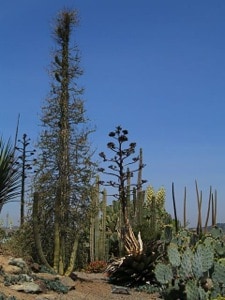 REGIONAL TRENDS
REGIONAL TRENDS
Ornamental landscape designs in southern California have long followed recognizable trends. California’s gardens can easily be “dated” by their look and their components. As in the fashion industry, certain appearances and materials come and go, in and out of vogue, depending on supply, demand, popularity, environmental circumstances, and the architectural community. During periods of water shortage, plants touted as “drought tolerant” come to the forefront. When the water supply is fat, conservation is forgotten, or unmentioned. One can look back at periods not too long ago when tropicals were all the rage. Evidently we experienced a phase heavy on palms about ten years ago. About the same time, our landscapes were being choked with every color daylily (Hemerocallis varieties). The so-called ornamental grasses came in with much fanfare and have been used exclusively in garden design, or combined with all of the above ever since. Today it seems to be that we can’t get enough ground-cover roses, bougainvillea, flax plants (Phormium varieties), grasses, sedges, kangaroo paw, we see a resurgence of the old bird-of-paradise, and yes succulents, succulents, succulents… all in the name of “water conservation.”
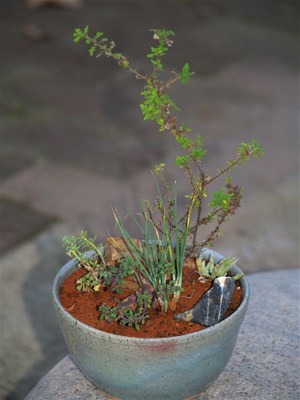
|
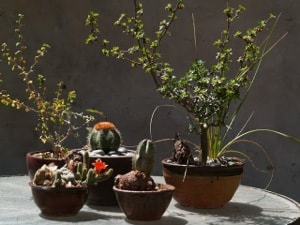
|
Today, you might find a typical ornamental garden (recently planted) obligingly conforming to the constraints of every other “trendy” design, and chances are, it will include exotic succulents… Aloe, Aeonium, Echeverria, Kalanchoe, Sedum, Agave, Crassula, Sempervivum, Euphorbia, Senecio. Any one of these would probably make a wonderful specimen in a pot, but when included in a hodgepodge of unrelated plants, (without regional or narrative context) the succulent planting is often static, out of place, lost. Add into the equation that most of the popular succulents today are strange variegated types, or brightly colored mutants, and the crazy-quilt design looks not only confused, but bizarre. Add yet another fact, that everywhere but at the immediate coast, many exotic succulents, shrink and shrivel in summer (unless they get a fair bit of irrigation), giving the whole weird landscape a scant, parched look. They are much less “drought tolerant” than our regionally native plants.
A conciliatory word. An expertly designed “succulent garden” can be a truly delightful experience. It will (by design) be very strange, a little like what you would see with mask and snorkel over a coral reef. Like any other theme garden, these plantings are best when they are featured for what they are… completely unique, special. Exclusive.
Therefore, the misuse of exotic succulents, especially their overuse in the name of “water conservation,” will detract from their individual natural attraction, yielding them common misfits amongst the other foreign shrubs, flowers, and grasses, and will reduce the true succulent garden found elsewhere, to be seen as just one more drought tolerant menagerie.
REGIONAL HONESTY
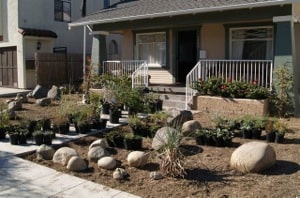 |
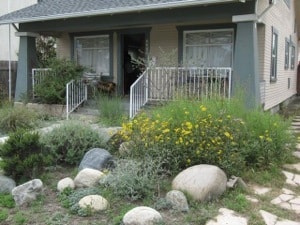 |
To achieve an authentic desert look in southern California, we simply combine native succulents as accents with other native plants in a regional context, resulting in a beautiful garden that is honest-at-face-value. Any legitimately “sustainable” landscape, (meeting the criteria for long-lasting beauty and resource/water conservation), should be designed with a local narrative, truly celebrating our unique “sense of place.”
When we listen to the story told by the remarkable natural ecosystems of San Diego, Baja California, and Sonora we get subtle hints on how to employ a very advanced design style. We’re speaking of one in which related plants work together as a cohesive whole, rather than trying to stand out individually in a collection of gaudy specimens. Try combining, boulders, rocks, pebbles, sticks and stones, other natural features, mounds and rivulets, and native plants including native succulents to create wonderful desert gardens; “stylized miniature ecosystems,” that reflect the subtle beauty of the dry country around San Diego, Baja and the Sonoran Desert.
Featured Photo Credit: Sarah Bryant, Tree of Life Nursery ©